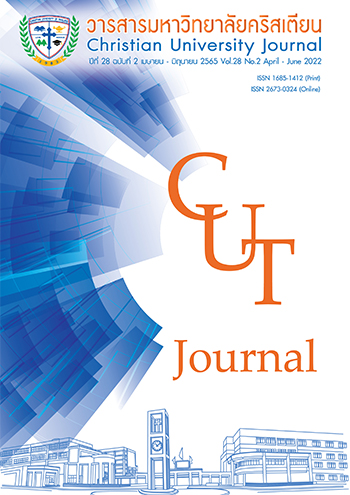ปัจจัยด้านความรู้ความเข้าใจและอารมณ์ที่มีอิทธิพลต่อความพึงพอใจ ของแบรนด์ร้านกาแฟท้องถิ่นในพนมเปญประเทศกัมพูชา
คำสำคัญ:
ความรู้ความเข้าใจ, อารมณ์, ความพึงพอใจของแบรนด์, ความตั้งใจในการซื้อซ้ำและการบอกต่อบทคัดย่อ
งานวิจัยนี้มีวัตถุประสงค์เพื่อตรวจสอบความสัมพันธ์ระหว่างตัวขับเคลื่อนความรู้ ความเข้าใจ (การรับรู้แบรนด์ การรับรู้คุณภาพ ภาพลักษณ์ของแบรนด์ และการรับรู้คุณค่า) ตัวขับเคลื่อนด้านอารมณ์ความรู้สึก (ความพอใจและความเร้าอารมณ์) ความพึงพอใจที่มีต่อแบรนด์ และความตั้งใจในการซื้อซ้ำและการบอกต่อ โดยใช้โมเดลสมการโครงสร้างแบบ PLS-SEM ซึ่งประกอบด้วยโมเดลการวัดและโมเดลโครงสร้าง แบบสอบถามได้ถูกแจกจ่ายไปยังกลุ่มเป้าหมายซึ่งเป็นผู้บริโภคกาแฟท้องถิ่นเจนวายที่อาศัยอยู่ในกรุงพนมเปญ ประเทศกัมพูชา ซึ่งรวบรวมแบบสอบถามได้ทั้งหมด 300 คนโดยใช้แบบสำรวจกูเกิ้ล
จากผลการวิจัย การรับรู้แบรนด์ การรับรู้คุณภาพ ภาพลักษณ์ของแบรนด์ และการรับรู้คุณค่ามีอิทฺธิพลในเชิงบวกต่อความพอใจ นอกจากนี้การรับรู้แบรนด์ ภาพลักษณ์ของแบรนด์ และการคุณค่ามีอิทฺธิพลในเชิงบวกต่อความเร้าอารมณ์ เช่นเดียวกันความพอใจและความเร้าอารมณ์มีอิทฺธิพลในเชิงบวกต่อความพึงพอใจที่มีต่อแบรนด์ และความพึงพอใจที่มีต่อแบรนด์มีอิทฺธิพลในเชิงบวกต่อความตั้งใจในการซื้อซ้ำและการบอกต่อ
ข้อเสนอแนะสำหรับผู้จัดการร้านกาแฟท้องถิ่นมีดังนี้ 1) เน้นการโฆษณาเพื่อเพิ่มระดับอารมณ์ของลูกค้าในการซื้อเครื่องดื่มที่ร้านกาแฟท้องถิ่น 2) ราคา รสชาติ และคุณภาพกาแฟควรพัฒนาเพิ่มขึ้นเพื่อทำให้มั่นใจได้ว่าลูกค้าเพลิดเพลินและพึงพอใจกับสินค้าหรือบริการที่ใช้ 3) สร้างโลโก้ที่มีเอกลักษณ์และมีความหมายเพื่อผลักดันให้ลูกค้าจดจำและรู้สึกคุ้นเคยกับผลิตภัณฑ์ 4) มุ่งเน้นที่พนักงานบริการที่ให้ความเอื้ออาทรต่อลูกค้าและทำให้พวกเขารู้สึกคุ้มค่ากับเวลาและเงินที่ใช้จ่ายในร้านกาแฟท้องถิ่น
เอกสารอ้างอิง
AEC Business Support Center. (2018). Trend of Chain Coffee shop and Café in Cambodia. Retrieved from https://th-th.facebook.com/aecth.cambodia/posts/trend-of-chain-coffee-shop-and-caf%C3%A9-in-cambodiakey-facts-number-of-shop-more-tha/1753 530824762718/
AsiaLife. (2016). Coffee Culture in the Capital. Retrieved from https://www.asialifemagazine. com/cambodia/coffee-culture-capital/
Asian Hotel & Cathering Times. (2016). Asia's coffee culture. Retrieved from https://asian hotelandcateringtimes.com/2016/08/asias-coffee-culture/
Bagozzi, R. P., & Yi, Y. (1988). On the Evaluation of Structural Equation Models. Journal of the Academy of Marketing Sciences, 16, 74-94. doi:10.1007/bf02723327
Brandimonte, M. A., Bruno, N., & Collina, S. (2006). Cognition. In P. Pawlik & G. d’Ydewalle (Eds.), Psychological Concepts: An International Historical Perspective. (pp.1-22.). Psychology Press, Hove, East Sussex, United Kingdom.
Businesswire. (2020). Global Coffee Market (2020 to 2024) - Insights & Forecast with Potential Impact of COVID-19 - ResearchAndMarkets.com. Retrieved from https://www.google.com/url?sa=t&rct=j&q=&esrc=s&source=web&cd=&cad=rja&uact=8&ved=2ahUKEwjr4cWU2_TqAhXWbCsKHbP9DuMQFjAAegQIARAB&url=https%3A%2F%2Fwww.businesswire.com%2Fnews%2Fhome%2F20200513005323%2Fen%2FGlobal-Coffee-Market-2020-2024---Insights&usg=AOvV
Dodds, B. W., Monroe, B. K., & Grewal, D. (1991). Effects of price, brand, and store information on buyers' product evaluations. Journal of Marketing Research, 28(3), 307-319. doi:10.2307/3172866
Ervelles, S. (1998). The role of affect in marketing. Journal of business research, 42(3), 199-215 . doi:10.1016/S0148-2963(97)00118-5
Green, S. B. (1991). How many subjects does it take to do a regression analysis. Multivariate Behavioral Research, 26(3), 499-510. doi:10.1207/s15327906mbr2603_7
Hair, J. F., Hult, G. T., M. Ringle, C., & Sarstedt, M. (2014). A primer on Partial Least Squares Structural Equation Modeling. Thousand Oaks, CA: Sage Publications, Inc.
Hair, J. F., Sarstedt, M., Pieper, T. M., & Ringle, C. M. (2012 ). The use of partial least squares structural equation modeling in strategic management research: A review of past practices and recommedations for future applications. Long Range Planning, 45(5-6), 320-340 . doi:10.1016/j.lrp.2012.09.008
Han, H., Nguyen, H. N., Song, H., Chua, B.-L., Lee, S., & Kim, W. (2018). Drivers of brand loyalty in the chain coffee shop industry. International Journal of Hospitality Management (72), 86-97.
Jang, S., & Namkung, Y. (2009). Perceived quality, emotions, and behavioural intentions: Application of an extended Mehrabian-Russell model to the restaurant. Journal of Business Research, 62(4), 451-460. doi: 10.1016/j.jbusres.2008.01.038
Konecnik, M., & Gartner, W. C. (2007). Customer-based brand equity for a destination. Annals of Tourism Research, 34(2), 400-421. doi: 10.1016/j.annals.2006.10.005
Ladhari, R. (2007). The Effect of Consumption Emotions on Satisfaction and Word-of-Mouth Communications. Psychology and Marketing, 24(12), 1085-1108.
Liljander, V., & Strandvik, T. (1997 ). Emotions in service satisfaction. International Journal of Service Industry Management, 8, 148-169 . doi:10.1108/09564239710166272
Mano, H., & Oliver, R. L. (1993). Assessing the dimensionality and structure of the consumption experience: evaluation, feeling, and satisfaction. Journal of consumer research, 20(3), 451-466. doi:10.1086/209361
Mehrabian, A., & Russell, J. A. (1974). An approach to environmental psychology. Cambridge, MA: M.I.T Press.
Oliver, C. (1991 ). Strategic responses to institutional processes. Academy of Management Review, 16, 145-179 . doi:10.5465/AMR.1991.4279002
Oliver, R. L. (1997). Satisfaction: A bahavioral perspective on the consumer. New York: The McGraw-Hill Companies, Inc.,.
Phillips, D. M., & Baumgartner, H. (2002 ). The role of consumption emotions in the satisfaction response. Journal of consumer psychology, 12(3), 243-252. doi:10.1207/ S15327663JCP1203_06
Ramnani, M. (2020). Coffee is the New Tea in Asia-Pacific. Retrieved from https://www. smartmarketnews.com/news/2020-07-14/coffee-is-the-new-tea-in-asia-pacific
Russell, A. J., & Pratt, G. (1980). A Descrption of the Affective Quality Attributed to Environments. Personality and Social Psychology, 38, 311-322.
ดาวน์โหลด
เผยแพร่แล้ว
ฉบับ
ประเภทบทความ
สัญญาอนุญาต
ลิขสิทธิ์ (c) 2022 มหาวิทยาลัยคริสเตียน

อนุญาตภายใต้เงื่อนไข Creative Commons Attribution-NonCommercial-NoDerivatives 4.0 International License.



